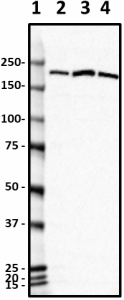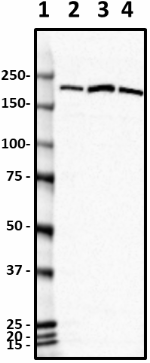- Clone
- A18140A (See other available formats)
- Regulatory Status
- RUO
- Other Names
- (E3-independent) E2 ubiquitin-conjugating enzyme, E2/E3 hybrid ubiquitin-protein ligase UBE2O, Ubiquitin carrier protein O, Ubiquitin-conjugating enzyme E2 O, Ubiquitin-conjugating enzyme E2 of 230 kD, Ubiquitin-protein ligase O
- Isotype
- Mouse IgG2b, κ
- Ave. Rating
- Submit a Review
- Product Citations
- publications

-

Western blot of purified anti-UBE2O antibody (clone A18140A). Lane 1: Molecular weight marker; Lane 2: 20 µg of human brain lysate; Lane 3: 20 µg of mouse brain lysate; Lane 4: 20 µg of rat brain lysate. The blot was incubated with 0.2 µg/mL of the primary antibody overnight at 4°C, followed by incubation with HRP goat anti-mouse IgG antibody (Cat. No. 405306). Enhanced chemiluminescence was used as the detection system. -

ICC staining of purified anti-UBE2O antibody (clone A18140A) on A431 cells. The cells were fixed with 4% PFA, permeabilized with a buffer containing 0.1% Triton X-100 and 0.25% BSA, and blocked with 2% normal goat serum and 0.02% BSA. The cells were then incubated with 0.5 µg/mL of the primary antibody overnight at 4°C, followed by incubation with 2.5 µg/mL of Alexa Fluor® 594 goat anti-mouse IgG antibody (Cat. No. 405326) for one hour at room temperature. The cells were co-stained with Flash Phalloidin™ Green 488 (Cat. No. 424201). Nuclei were counterstained with DAPI. The image was captured with a 60X objective. Scale bar: 20 µm
| Cat # | Size | Price | Quantity Check Availability | Save | ||
|---|---|---|---|---|---|---|
| 870201 | 25 µg | 85€ | ||||
| 870202 | 100 µg | 221€ | ||||
Ubiquitin-conjugating enzyme E2 O (UBE2O) is an E2/E3 hybrid enzyme that displays both E2 and E3 ligases activities and mediates ubiquitination of many target proteins involved in a wide range of processes, including the 5’-AMP-activated protein kinase catalytic subunit a2 (AMPKa2), tumor suppressor ubiquitin carboxyl-terminal hydrolase BAP1, mixed-lineage leukemia (MLL) protein, SMAD family member 6 (SMAD6), transcription factor c-Maf, and free ribosomal proteins. Abnormal expression and mutations in UBE2O are observed in tumorigenesis and are associated with poor prognosis of gastric, lung, breast, and prostate cancers.
Product DetailsProduct Details
- Verified Reactivity
- Human, Mouse, Rat
- Antibody Type
- Monoclonal
- Host Species
- Mouse
- Immunogen
- Recombinant human UBE2O protein
- Formulation
- Phosphate-buffered solution, pH 7.2, containing 0.09% sodium azide
- Preparation
- The antibody was purified by affinity chromatography.
- Concentration
- 0.5 mg/mL
- Storage & Handling
- The antibody solution should be stored undiluted between 2°C and 8°C.
- Application
-
WB - Quality tested
ICC - Verified - Recommended Usage
-
Each lot of this antibody is quality control tested by western blotting. For western blotting, the suggested use of this reagent is 0.2 - 5.0 µg/mL. For immunocytochemistry, a concentration range of 0.5 - 10 μg/mL is recommended. It is recommended that the reagent be titrated for optimal performance for each application.
- RRID
-
AB_2820188 (BioLegend Cat. No. 870201)
AB_2820189 (BioLegend Cat. No. 870202)
Antigen Details
- Structure
- Human UBE2O is a 1,292 amino acid protein with a predicted molecular mass of 141 kD and observed molecular mass of ~200 kD
- Distribution
-
Tissue distribution: Brain, skeletal muscle, heart
Cellular distribution: Nucleus, cytosol - Function
- UBE2O is an E2/E3 hybrid ubiquitin-protein ligase that is crucial for protein ubiquitination and degradation.
- Cell Type
- Astrocytes, Microglia, Neurons, Oligodendrocytes
- Biology Area
- Neurodegeneration, Neuroscience, Protein Misfolding and Aggregation, Ubiquitin/Protein Degradation
- Molecular Family
- Ligases
- Antigen References
-
- Ullah K, et al. 2019. FEBS J. 286(11):2018-2034.
- Chen S, et al. 2018. J Biol Chem. 293(29):11296-11309.
- Mashtalir N, et al. 2014. Mol Cell. 54(3):392-406.
- Gene ID
- 63893 View all products for this Gene ID
- UniProt
- View information about UBE2O on UniProt.org
Related Pages & Pathways
Pages
Related FAQs
Other Formats
View All UBE2O Reagents Request Custom Conjugation| Description | Clone | Applications |
|---|---|---|
| Purified anti-UBE2O | A18140A | WB,ICC |
Compare Data Across All Formats
This data display is provided for general comparisons between formats.
Your actual data may vary due to variations in samples, target cells, instruments and their settings, staining conditions, and other factors.
If you need assistance with selecting the best format contact our expert technical support team.
 Login / Register
Login / Register 









Follow Us